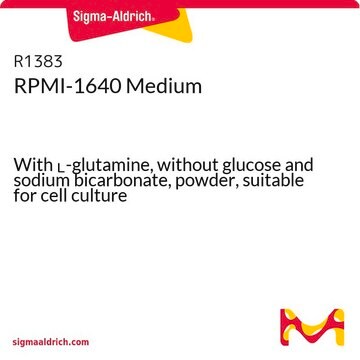R7509
RPMI-1640 Medium
With sodium bicarbonate, without ʟ-glutamine and phenol red, Sterile liquid,suitable for cell culture
Synonym(s):
Roswell Park Memorial Institute 1640 medium
About This Item
Recommended Products
product name
RPMI-1640 Medium, Modified, with sodium bicarbonate, without L-glutamine and phenol red, liquid, sterile-filtered, suitable for cell culture
Quality Level
sterility
sterile-filtered
form
liquid
technique(s)
cell culture | mammalian: suitable
impurities
endotoxin, tested
components
phenol red: no
L-glutamine: no
HEPES: no
sodium pyruvate: no
NaHCO3: yes
shipped in
ambient
storage temp.
2-8°C
Looking for similar products? Visit Product Comparison Guide
Related Categories
General description
Application
- to culture Mantle cell lymphoma cells
- to culture mouse podocytes
- in the extraction of whole bone marrow from rat Femur and tibia bones
Other Notes
Use this medium when working with stem cells or when growing cells at low densities.
Also recommended for in vitro diagnostics use.
also commonly purchased with this product
supplement
Storage Class Code
12 - Non Combustible Liquids
WGK
WGK 1
Flash Point(F)
Not applicable
Flash Point(C)
Not applicable
Certificates of Analysis (COA)
Search for Certificates of Analysis (COA) by entering the products Lot/Batch Number. Lot and Batch Numbers can be found on a product’s label following the words ‘Lot’ or ‘Batch’.
Already Own This Product?
Find documentation for the products that you have recently purchased in the Document Library.
Customers Also Viewed
Our team of scientists has experience in all areas of research including Life Science, Material Science, Chemical Synthesis, Chromatography, Analytical and many others.
Contact Technical Service





